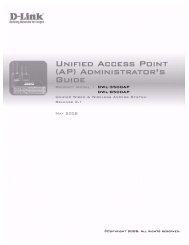Product Manual
Product Manual
Product Manual
Create successful ePaper yourself
Turn your PDF publications into a flip-book with our unique Google optimized e-Paper software.
VLANs<br />
Understanding IEEE 802.1p Priority<br />
DES-3526 / DES-3526DC Fast Ethernet Layer 2 Switch<br />
Priority tagging is a function defined by the IEEE 802.1p standard designed to provide a means of<br />
managing traffic on a network where many different types of data may be transmitted simultaneously.<br />
It is intended to alleviate problems associated with the delivery of time critical data over congested<br />
networks. The quality of applications that are dependent on such time critical data, such as video<br />
conferencing, can be severely and adversely affected by even very small delays in transmission.<br />
Network devices that are in compliance with the IEEE 802.1p standard have the ability to recognize<br />
the priority level of data packets. These devices can also assign a priority label or tag to packets.<br />
Compliant devices can also strip priority tags from packets. This priority tag determines the packet's<br />
degree of expeditiousness and determines the queue to which it will be assigned.<br />
Priority tags are given values from 0 to 7 with 0 being assigned to the lowest priority data and 7<br />
assigned to the highest. The highest priority tag 7 is generally only used for data associated with video<br />
or audio applications, which are sensitive to even slight delays, or for data from specified end users<br />
whose data transmissions warrant special consideration.<br />
The Switch allows you to further tailor how priority tagged data packets are handled on your network.<br />
Using queues to manage priority tagged data allows you to specify its relative priority to suit the needs<br />
of your network. There may be circumstances where it would be advantageous to group two or more<br />
differently tagged packets into the same queue. Generally, however, it is recommended that the<br />
highest priority queue, Queue 1, be reserved for data packets with a priority value of 7. Packets that<br />
have not been given any priority value are placed in Queue 0 and thus given the lowest priority for<br />
delivery.<br />
A weighted round robin system is employed on the Switch to determine the rate at which the queues<br />
are emptied of packets. The ratio used for clearing the queues is 4:1. This means that the highest<br />
priority queue, Queue 1, will clear 4 packets for every 1 packet cleared from Queue 0.<br />
Remember, the priority queue settings on the Switch are for all ports, and all devices connected to the<br />
Switch will be affected. This priority queuing system will be especially beneficial if your network<br />
employs switches with the capability of assigning priority tags.<br />
VLAN Description<br />
A Virtual Local Area Network (VLAN) is a network topology configured according to a logical<br />
scheme rather than the physical layout. VLANs can be used to combine any collection of LAN<br />
segments into an autonomous user group that appears as a single LAN. VLANs also logically segment<br />
the network into different broadcast domains so that packets are forwarded only between ports within<br />
the VLAN. Typically, a VLAN corresponds to a particular subnet, although not necessarily.<br />
VLANs can enhance performance by conserving bandwidth, and improve security by limiting traffic<br />
to specific domains.<br />
A VLAN is a collection of end nodes grouped by logic instead of physical location. End nodes that<br />
frequently communicate with each other are assigned to the same VLAN, regardless of where they are<br />
physically on the network. Logically, a VLAN can be equated to a broadcast domain, because<br />
broadcast packets are forwarded to only members of the VLAN on which the broadcast was initiated.<br />
Notes About VLANs on the DES-3526<br />
No matter what basis is used to uniquely identify end nodes and assign these nodes VLAN membership,<br />
packets cannot cross VLANs without a network device performing a routing function between<br />
the VLANs.<br />
59

















